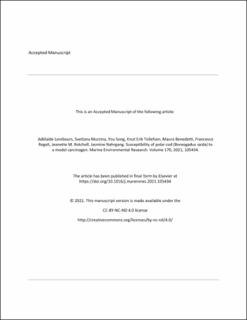| dc.contributor.author | Lerebours, Adélaïde | |
| dc.contributor.author | Murzina, Svetlana | |
| dc.contributor.author | Song, You | |
| dc.contributor.author | Tollefsen, Knut-Erik | |
| dc.contributor.author | Benedetti, Maura | |
| dc.contributor.author | Regoli, Francesco | |
| dc.contributor.author | Rotchell, Jeanette M. | |
| dc.contributor.author | Nahrgang, Jasmine | |
| dc.date.accessioned | 2021-10-12T09:17:40Z | |
| dc.date.available | 2021-10-12T09:17:40Z | |
| dc.date.created | 2021-09-30T11:02:45Z | |
| dc.date.issued | 2021 | |
| dc.identifier.citation | Marine Environmental Research. 2021, 170, 105434. | en_US |
| dc.identifier.issn | 0141-1136 | |
| dc.identifier.uri | https://hdl.handle.net/11250/2789239 | |
| dc.description | Embargo until July 27, 2023. | en_US |
| dc.description.abstract | Studies that aim to characterise the susceptibility of the ecologically relevant and non-model fish polar cod (Boreogadus saida) to model carcinogens are required. Polar cod were exposed under laboratory conditions for six months to control, 0.03 μg BaP/g fish/week and 0.3 μg BaP/g fish/week dietary benzo(a)pyrene (BaP), a reference carcinogen. The concentrations of the 3-OH-BaP bile metabolite and transcriptional responses of genes involved in DNA adduct recognition (xpc), helicase activity (xpd), DNA repair (xpf, rad51) and tumour suppression (tp53) were assessed after 0, 1, 3 and 6 months of exposure, alongside body condition indexes (gonadosomatic index, hepatosomatic index and condition factor). Micronuclei and nuclear abnormalities in blood and spleen, and liver histopathological endpoints were assessed at the end of the experiment. Fish grew steadily over the whole experiment and no mortality was recorded. The concentrations of 3-OH-BaP increased significantly after 1 month of exposure to the highest BaP concentration and after 6 months of exposure to all BaP concentrations showing the biotransformation of the mother compound. Nevertheless, no significant induction of gene transcripts involved in DNA damage repair or tumour suppression were observed at the selected sampling times. These results together with the absence of chromosomal damage in blood and spleen cells, the subtle increase in nuclear abnormalities observed in spleen cells and the low occurrence of foci of cellular alteration suggested that the exposure was below the threshold of observable effects. Taken together, the results showed that polar cod was not susceptible to carcinogenesis using the BaP exposure regime employed herein. | en_US |
| dc.language.iso | eng | en_US |
| dc.publisher | Elsevier | en_US |
| dc.rights | Attribution-NonCommercial-NoDerivatives 4.0 Internasjonal | * |
| dc.rights.uri | http://creativecommons.org/licenses/by-nc-nd/4.0/deed.no | * |
| dc.title | Susceptibility of polar cod (Boreogadus saida) to a model carcinogen | en_US |
| dc.type | Peer reviewed | en_US |
| dc.type | Journal article | en_US |
| dc.description.version | acceptedVersion | en_US |
| dc.source.pagenumber | 9 | en_US |
| dc.source.volume | 170 | en_US |
| dc.source.journal | Marine Environmental Research | en_US |
| dc.identifier.doi | 10.1016/j.marenvres.2021.105434 | |
| dc.identifier.cristin | 1941201 | |
| dc.source.articlenumber | 105434 | en_US |
| cristin.ispublished | true | |
| cristin.fulltext | postprint | |
| cristin.qualitycode | 2 | |

